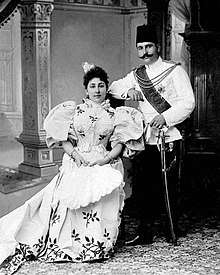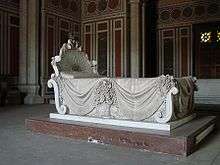Shivakiar Ibrahim
Shivakiar Ibrahim (Turkish: Şivekâr İbrahim) (25 October 1876 – 17 February 1947[1]) was an Egyptian princess and a member of the Muhammad Ali Dynasty. She was the first wife of King Fuad.
| Shivakiar Ibrahim | |||||
|---|---|---|---|---|---|
| Princess of Egypt | |||||
.jpg) A nineteenth or twentieth century photograph of Shivakiar Ibrahim | |||||
| Born | 25 October 1876 Scutari (formerly Scutrai), Istanbul, Ottoman Empire | ||||
| Died | 17 February 1947 (aged 70) Kasr al-Aali Palace, Cairo, Kingdom of Egypt | ||||
| Burial | |||||
| Spouse | Fuad I (m. 1896 - div. 1898) Abdul Rauf Sabit Bey (m. 14 March 1900 - div. 1903) Saifullah Yusri Pasha (m. 2 January 1904 - div. 10 January 1916) Muhammad Salim Khalil Bey Demirkan (m. 5 July 1917 div. 2 March 1925) Ilhami Husain Pasha (m. 1 July 1927 - d. 17 February 1947) | ||||
| Issue | From first husband: Prince Ismail Princess Fawkia From second husband: one son one daughter From third husband: Vahid Yusri Pasha Lutfia Khanum From fourth husband: Muhammad Vahid ud-din Khalil | ||||
| |||||
| House | House of Muhammad Ali | ||||
| Father | Prince Ibrahim Fahmi Ahmad Pasha of Egypt | ||||
| Mother | Vijdan Navjuvan Khanum | ||||
| Religion | Sunni Islam | ||||
Family
Princess Shivakiar of Egypt was born on 25 October 1876 in Üsküdar (formerly Scutrai), Istanbul. She was the only daughter of Field Marshal, Prince Ibrahim Fahmi Ahmad Pasha and his first wife, Vijdan Navjuvan Khanum, an ethnic Circassian from the household of Ali Sharif Pasha. Shivakiar had two brothers, Prince Ahmad Saif ud-din Ibrahim Bey and Prince Muhammad Vahid ud-din Ibrahim Bey.[2] Her mother was divorced and was married secondly to Faridun Pasha, Lieutenant-General in the Imperial Ottoman Army.
She was named after her paternal great-grandmother, the second wife of Ibrahim Pasha.
Marriages

Princess Shivakiar first married her first cousin once removed Prince Ahmed Fuad (first cousin of her father), who later became the King of Egypt, on 30 May 1895 (nikah), and at the Abbasiya Palace, on 14 February 1896 (zifaf). Fuad and Shivakiar had been no match whatsoever to each other. She brought him a son, Ismail, who died in infancy and Fawkia, a daughter.[2][3] Prince Fuad was deeply attached to his wife, but in May 1898, three years after their marriage the princess obliged him to divorce her and embarked on the series of matrimonial ventures which resulted in her having five successive husbands and four divorces.[2] During a dispute with her brother, Fuad was shot in the throat. He survived, but carried that scar the rest of his life.[4]
She married secondly to Abdul Rauf Sabit Bey. Shivakiar had one son and one daughter by him. She divorced him in 1903. She married thirdly on 2 January 1904, as his second wife, to Saifullah Yusri Pasha, a Yeghen, and had one son, Vahid Yusri Pasha and a daughter, Lutfia Khanum by him. Shivakiar divorced him on 10 January 1916. She married fourthly on 5 July 1917 to Muhammad Salim Khalil Bey Demirkan, and had one son, Muhammad Vahid ud-din Khalil by him. Shivakiar divorced him on 2 March 1925.[1]
Later life and death

She married lastly to Ilhami Husain Pasha on 1 July 1927. Towards the end of her life she devoted herself to the furtherance of social welfare and, as the president of the Muhammad Ali Benevolent Society, and of the ‘Mar’al-Guedida’ (New Woman), a society which trained young girls for various professions, notably nursing and dress-making, rendered great service to her country.[2] During her last years she was renowned both for the splendour of her entertainments and for her unfailing charity. She was also the author of "Mon pays: la renovation de l'Egypte, Mohammed Aly" which was published in 1933, and The Pharaoh Ne-Ouser-Ra and His Little Slave Girl. Princess Shivakiar used to live close to Prince Yousuof Kemal's palace, in a spacious villa which he had lent to her.[5] When she inherited from her brother Prince Ahmad Saif ud-din Ibrahim Bey, she went to live in a palace opposite parliament which had been built by Ali Pasha Gelal, son of Princess Zubeida and Menelikli Pasha.[5]
Princess Shivakiar, also had a "gallery of ancestors" at her Cairo palace, where she housed busts of all the viceroys down to a huge statue of King Faruk, the last ruler of the Muhammad Ali dynasty.[6]
She died at the Kasr al-Aali Palace, Cairo on 17 February 1947 and was buried in Hosh al-Basha, Imam al-Shafi'i, Cairo, Egypt.[2] After her death her youngest son, Muhammad Vahid ud-din Khalil, asked Prince Youssouf to allow him to buy the Princess's original villa, and the prince agreed.[5] Princess Shivakiar's son then proceed to make the palace more palatial, installing, among other things, a splendid, aubergine marble staircase. The garden was transformed, along completely formal lines, very pleasantly and successively.[5]
Ancestry
| Ancestors of Shivakiar Ibrahim | |||||||||||||||||||||||||||||||||||||||||||||||||||||||||||||||||||||||||||||||||||||||||||||||||||||||||||||||||||||||||||||||||||||||||||||||||||||||||||||||||||||||||||||||||||||||||||||||||||||||||||||||||||||||||||||||||||||||||||||||||||||||||||||||||||||||||||||||||||||||||||||||||||||||||||||||||||||||||||||||||||||||||||||||||||||||||||||||||||||||||||||||||||||||||||||||||||||||||||||||||||||||||||||||||||||||||||||||||||||||||||||||||||||||||||||||||||
|---|---|---|---|---|---|---|---|---|---|---|---|---|---|---|---|---|---|---|---|---|---|---|---|---|---|---|---|---|---|---|---|---|---|---|---|---|---|---|---|---|---|---|---|---|---|---|---|---|---|---|---|---|---|---|---|---|---|---|---|---|---|---|---|---|---|---|---|---|---|---|---|---|---|---|---|---|---|---|---|---|---|---|---|---|---|---|---|---|---|---|---|---|---|---|---|---|---|---|---|---|---|---|---|---|---|---|---|---|---|---|---|---|---|---|---|---|---|---|---|---|---|---|---|---|---|---|---|---|---|---|---|---|---|---|---|---|---|---|---|---|---|---|---|---|---|---|---|---|---|---|---|---|---|---|---|---|---|---|---|---|---|---|---|---|---|---|---|---|---|---|---|---|---|---|---|---|---|---|---|---|---|---|---|---|---|---|---|---|---|---|---|---|---|---|---|---|---|---|---|---|---|---|---|---|---|---|---|---|---|---|---|---|---|---|---|---|---|---|---|---|---|---|---|---|---|---|---|---|---|---|---|---|---|---|---|---|---|---|---|---|---|---|---|---|---|---|---|---|---|---|---|---|---|---|---|---|---|---|---|---|---|---|---|---|---|---|---|---|---|---|---|---|---|---|---|---|---|---|---|---|---|---|---|---|---|---|---|---|---|---|---|---|---|---|---|---|---|---|---|---|---|---|---|---|---|---|---|---|---|---|---|---|---|---|---|---|---|---|---|---|---|---|---|---|---|---|---|---|---|---|---|---|---|---|---|---|---|---|---|---|---|---|---|---|---|---|---|---|---|---|---|---|---|---|---|---|---|---|---|---|---|---|---|---|---|---|---|---|---|---|---|---|---|---|---|---|---|---|---|---|---|---|---|---|---|---|---|---|---|---|---|---|---|---|---|---|---|---|---|---|---|---|---|---|---|---|---|---|---|---|---|---|---|---|---|---|---|---|---|---|---|---|---|---|---|---|---|---|---|---|---|---|---|---|---|---|---|---|---|---|---|---|---|---|---|---|---|---|---|---|---|---|---|---|---|---|---|---|---|---|---|---|---|---|---|---|---|
| |||||||||||||||||||||||||||||||||||||||||||||||||||||||||||||||||||||||||||||||||||||||||||||||||||||||||||||||||||||||||||||||||||||||||||||||||||||||||||||||||||||||||||||||||||||||||||||||||||||||||||||||||||||||||||||||||||||||||||||||||||||||||||||||||||||||||||||||||||||||||||||||||||||||||||||||||||||||||||||||||||||||||||||||||||||||||||||||||||||||||||||||||||||||||||||||||||||||||||||||||||||||||||||||||||||||||||||||||||||||||||||||||||||||||||||||||||
References
- Christopher Buyers. "The Royal Ark – Royal and Ruling Houses of Africa, Asia, Oceania and the Americas". 4dw.net. Retrieved 23 September 2014.
- Reina Lewis, Nancy Micklewright (9 Jul 2006). Gender, Modernity and Liberty: Middle Eastern and Western Women's Writings: A Critical Sourcebook. I.B.Tauris. p. 241. ISBN 978-1-860-64956-1.
- Bassil A Mardelli (24 May 2010). Middle East Perspectives. iUniverse. ISBN 978-1-450-21118-5.
- History and photographs of Muhammad Ali dynasty
- Hassan Hassan (1 Jan 2000). In the House of Muhammad Ali: A Family Album, 1805-1952. American Univ in Cairo Press. pp. 57–8. ISBN 978-9-774-24554-1.
- Jayne L. Warner (2001). Cultural Horizons: A festschrift in honor of Talat S. Halman, Volume 1. Syracuse University Press. ISBN 978-0-815-68132-8.
External Links
- Mausoleum of Princess Shavakiar Ibrahim, Bab Al-Khalk, Cairo - https://www.youtube.com/watch?v=yuh0BCCJVuQ